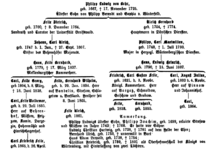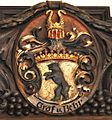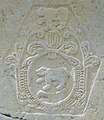Behr (noble family)
The von Behr family is a Lower Saxon and Pomeranian nobility . As early as 1105–1167, Hermann von Behr was identified as canon and later archdeacon in Halberstadt .
history
The sex itself traces its ancestry back to the noble free Hugold (1148–1162), who was a brother of Bishop Hermann von Verden and Vogt of Hermannsburg. However, according to the current state of research, this is questionable and the connection to the following families cannot be documented. Presumably, Bishop Hermann von Verden and his brother Hugold were noble lords of Ampfurth. (see weblink)
At the end of the 12th century, Eberhard Bere appeared in the entourage of Henry the Lion and his sons. All four tribes of the families named Bere and Ursus (document Latin), as well as the black bear in the coat of arms, trace their origin to this Eberhard .
The oldest recorded tribe of the Osnabrück Bere (later called Baer and Bar ) from 1204 was followed by the Pommern-Gützkower tribe in 1224, the Pommern-Rügen tribe in 1231 and the Lower Saxony-Lüneburg tribe in 1259.
The von Behr family spread to Pomerania-Rügen and Pommern-Gützkow as early as the 13th century, where they became influential landowners with extensive estates. The Rügen Behr were so named because their possessions were initially in the area of the mainland part of the Principality of Rügen. This tribe was also incorrectly referred to as Mecklenburg because large parts of their possessions extended from Western Pomerania to Mecklenburg. In the 18th century, the family took the name of Behr-Negendank. The Gützkower Behrs called themselves so because their possessions were in what was then the county of Gützkow, later the Greifswald district.
- Lueneburg tribe
Since the middle of the 13th century, the von Behrs have belonged to the Lüneburg nobility, from 1470 until today on the Stellichte estate . From this tribe Dietrich von Behr went to Courland in 1550 . There the Behrs built, among other things, the Popen Manor in 1653 (today Pope in the Ventspils district , Latvia).
Stellichte , Lower Saxony (owned by the family since 1470)
- Osnabrück tribe
→ See main article: Bar (noble family)
- Tribe of Pomerania-Gützkow
For the tribe of Pomerania-Gützkow, the oldest surviving loan letter from the Behrs was issued on September 28, 1275 by Duke Barnim I and his son Bogislaw IV , without names of properties being listed in the document.
Only the loan letter of 1491 for Harnid (1), Harnid (2), Heinrich and Gerhard von Behr sat zu Müssow, Vargatz and Schlagtow names all possessions of the family in total. These are in detail: Müssow , Vargatz , Schlagtow , Busdorf (later called Behrenhoff ), Negentin , Kiesow , Stresow, Schmoldow , Bandelin , Dargezin, Strellin , Gnatzkow (later called Karlsburg ), Schlatkow , Sanz and Karzin (?).
The originals of the loan letters (Güter und Bede) were in the old Bandeliner lock, they burned in 1928 with the lock and the entire inventory. All that remained was copies and modern photographs, as well as the old translations.
In 1277 Heinrich von Behr and his son Henning acquired large estates in the East Pomeranian rule of Bütow , both of whom were marshals of the Pomeranian dukes at the time. But they lost these possessions around 1326 and then turned to Mecklenburg, where their family died out around 1580. But this line belonged to the Gützkow / Pomerania tribe.
Felix von Behr-Bandelin auf Bandelin received the title of baron from the king in Stralsund on June 8, 1865, but this was only limited to his person. In 1877 the Behrenhoffer and in 1878 the Bandeliners from Behr received the title of Count, the old Friedrich von Behr auf Vargatz and Schmoldow rejected the increase in status, which was valid for the whole family. Therefore the different coat of arms variants in the district building of the district Greifswald, where the coat of arms friezes of the district council members (24 lords and 3 cities) were attached. A double coat of arms of the Behrenhoffer and Bandeliner counts was dispensed with because Carl (Charly) von Behr-Behrenhoff, as district administrator, was not a direct member of the district council.
When Count von Behr died in 1933, his nephew inherited the estate, but in his will his widow Mechtild received Countess von Behr, nee. von Heyden, the lifelong right of use for Behrenhoff. It was she who made Behrenhoff Castle available to the Confessing Church (opponent of Hitler's state church) and the later murdered Dietrich Bonhoeffer for readings and training of theologians in 1936/37 . She aroused the attention and displeasure of the Nazi state and was taken into "protective custody" in 1940.
Bandelin (owned by the family from 1250 to 1945)
Vargatz (1250 to 1892)
Behrenhoff 1920 (before 1387 to 1945)
Schmoldow 1910 (before 1343 to 1892)
- Pomerania-Rügen tribe
Representatives of this family were hereditary chefs from Pomeranian Duke Bogislaw XIII. of the Principality of Rügen and the State of Barth. Since this family also had larger estates in Mecklenburg, including Behren-Lübchin and Dölitz near Gnoien , they are incorrectly referred to as the Mecklenburg family line.
The Behr-Negendank family, richly wealthy in the Pomerania - Mecklenburg border area, emerged from the Rügen / Pomerania tribe with the headquarters of Schloss Semlow , which they acquired before 1398 . In the 18th century, Karl August von Behr adopted the combined name of Behr- Negendank . In 1861 Ulrich von Behr-Negendank received the Prussian title of Count from the House of Semlow . Plennin , Kavelsdorf and Katzenow belonged to Semlow . Passow belonged to the Negendank legacy.
Semlow (owned by the family from 1398 to 1945)
In 1862, a branch was granted Russian recognition for the use of the baron title. A family association that was established in the 19th century and re-established in 1953 unites the tribes of the counts , barons and lords of Behr and Behr-Negendank.
coat of arms
The von Behr family has four family coats of arms .
- The Rügen / Pomeranian shows a striding black bear with a gold collar in silver. On the helmet with black and silver blankets the bear.
- The Gützkow / Pommersche shows an upright black bear in silver. On the helmet with black and silver covers, two averted silver swan necks.
- The Lower Saxon and Courland shows a striding black bear in silver. On the helmet with black and silver covers the bear in front of a natural peacock frond of seven, the stems banded with red peacock feathers.
- The younger coat of arms of the Osnabrück von Baer, whose relationship to the von Behr treated here is not certain, shows in silver a black bear with a gold collar climbing on an oblique black and silver chess. On the helmet with the black and silver covers a bundle of black notched sticks.
The von Behr-Negendank have a four-part coat of arms: one and four is the striding bear of the Rügen / Pomeranian tribe, two and three are divided by a left silver tip of gold and red († 1767 Negendank ).

In addition, the Behr in the landscapes of Lüneburg, Gützkow, Stargard and Rügen also carried completely different coats of arms, including with swan necks in the shield, or with two rising tips and roses in them.
Relatives
Tribe Gützkow
- Lippold von Behr, 1248 Truchseß of the Pomeranian Duke Wartislaw III.
- Heinrich von Behr, (brother of Lippold), Marshal of the Pomeranian Dukes
- Henning von Behr (son of Heinrich), around 1321–1326 Marshal of the Pomeranian Dukes, emigrated to the state of Stargard / Mecklenburg after 1326, the family died there in 1580.
- Henning Ernst von Behr (1706–1783), Prussian major general
- Friedrich von Behr (1821–1892), Schmoldow House, Prussian politician, President of the German Fisheries Association
- Carl Felix Woldemar Graf von Behr (1835–1906), manor owner and administrative lawyer in the province of Pomerania , member of the Reichstag
- Carl Friedrich Felix Graf von Behr (1865–1933), House Behrenhoff, manor owner in the province of Pomerania and Prussian politician.
- Kurt von Behr (1890–1945), Haus Hindenberg, Oberführer of the DRK, head of the “West Department” in the task force Reichsleiter Rosenberg
Tribe of Rügen
- Samuel von Behr († 1621), Mecklenburg Chancellor and close confidante of Duke Adolf Friedrich I of Mecklenburg-Schwerin
- Cord von Behr, from Greese, monastery captain from 1653 to 1659 in the Dobbertin monastery , his grave slab is on the western extension of the monastery captain's house
- Anna Sophia von Behr from the Zülow house (1642–1705), entered as No. 1 in the registration book kept in Dobbertin Monastery from 1696 , was the head of the women's monastery from 1691 to 1705 as the dominatrix there
- Matthias Johann von Behr (1685–1729), Mecklenburg diplomat and historian
- Carl von Behr-Negendank (1791–1827), Pomeranian landowner and politician
- Hermann August Friedrich von Behr-Negendank (1801–1887), ducal Anhalt Chamberlain , Majorate Lord on Torgelow , Passow , Behren-Lübchin , Neverin , Rabenhorst and Kavelsdorf, promoter of church buildings and their inventory
- Ulrich Graf von Behr-Negendank (1826–1902), Pomeranian landowner, historical researcher and Prussian politician
- Konrad von Behr (1852–1929), Prussian " Real Secret Councilor ", President of the State Cultural Office
- August Graf von Behr-Negendank (1866–1942), Fideikommissherr on Semlow , member of the Prussian mansion , hereditary kitchen master of the Principality of Rügen and the Lande Barth , Prussian Chamberlain , Prussian Rittmeister dR
- Hugold von Behr (1866 - unknown), Prussian officer and officer in the Wissmann troop
- Max von Behr (1879–1951), German lieutenant general
- Heinrich von Behr (1887–1951), German lieutenant general
- Sophie von Behr (1935–2015), (von Behr-Negendank), German journalist and writer
- Vicke von Behr-Negendanck (* 1949), Archoberlenker of the Christian Community since 2005
Tribe Lüneburg
- Burchard Christian von Behr (1714–1771), Higher Appeal Judge, Minister of the Electorate of Braunschweig-Lüneburg and curator of the Georg-August University of Göttingen
- Ottmar von Behr (1810–1856), German-American farmer and sheep breeder, meteorologist and naturalist
- Heinrich Baron von Behr (1902–1983), Kurland line, major general in the Wehrmacht and later in the Bundeswehr
Family burial and memorial sites
Equestrian statue of Count Samuel von Behr († 1621), Mecklenburg Chancellor, in the Doberan Minster
Coronation altar of Mary , donated by the Behr family around 1440, originally in Dorow , from 1606 in Deyelsdorf , from 1870 in Semlow , since 1972 in the St. Marien Church (Stralsund)
Behr grave slab from 1698 in the village church of Basse , Rügen / Pomeranian tribe with bears as helmet decorations
Cord von Behr 1653–1659 monastery captain in Dobbertin , grave slab around 1660 at the monastery captain's house
Web links
literature
- Friedrich Lisch : Documents and research on the history of the Behr family , Volumes I to IV, Schwerin 1861 to 1863.
- F. Vogell: Attempt to establish a gender history of the noble house of Messrs Behr in Hanover and Curland: drafted from partly already printed, partly unprinted documents . Celle: Schweiger u. Pick, 1815 ( digitized version )
- Ulrich Graf von Behr-Negendank : Documents and research on the history of the Behr family , Volumes V and VI, Berlin 1894 and 1897
- Deutsche Adelsgenossenschaft (Ed.): Year book of the German nobility , Volume 3, 1899, published by WT Bruer, p. 11 - digitized
- Otto Magnus von Stackelberg (edit.): Genealogical manual of the Estonian knighthood , part 2, 3: Estonia, Bd .: 3, Görlitz, 1930 pp. 27-28
- Oskar Stavenhagen : Genealogical Handbook of the Courland Knights , Part 3, 2: Courland, Lfg. 9-12, Vol .: 2, Görlitz, 1937 p. 767ff and p. 787-811
- Genealogisches Handbuch des Adels , Volume 53, Adelslexikon , 1972, CA Starke Verlag
- Marcelle and Fritz von Behr: Documents and research on the history of the Behr family, Gützkower Line (Die Schwanenhälsigen) , Volume VII, Part I and II, Bremen 1989.
- Heinrich Berghaus : Land book of the Duchy of Pomerania and the Principality of Rügen . IV. Part II. Volume: Greifswalder Kreis . Anklam 1868, online .
- Gothaisches genealogical pocket book of noble houses 1901 . First year, p. 36 Bar; P. 66ff Behr
Individual evidence
- ↑ a b Friedrich Lisch : Documents and research on the history of the Behr family , volumes I to IV, Schwerin 1861 to 1863, volume 1, p. 34 ( online )
- ^ History of the manor Stellichte
- ^ Dietrich von Behr
- ↑ Friedrich Lisch : Documents and research on the history of the Behr family , Volumes I to IV, Schwerin 1861 to 1863.
- ^ PUB 1018. In: Rodgero Prümers (Hrsg.): Pommersches Urkundenbuch . Vol. 2, 1st division, 1254-1278, Stettin 1881, p. 312.
- ^ A b Heinrich Berghaus : Land book of the Duchy of Pomerania and the Principality of Rügen . IV. Part II. Volume: Greifswalder Kreis . Anklam 1868, p. 46 ( Google Books ).
- ^ Hubertus Neuschäffer: Western Pomerania's castles and mansions. Husum Druck- und Verlagsgesellschaft 1993, p. 31, ISBN 3-88042-636-8
- ↑ Friedrich Lisch : Documents and research on the history of the Behr family , Volumes I to IV, Schwerin 1861 to 1863.
- ↑ Friedrich Lisch : Documents and research on the history of the Behr family , volumes I to IV, Schwerin 1861 to 1863, volume 1, p. 4, table 1
- ↑ Documents and research on the history of the Behr family , volume 1, seal tables I – XI
- ^ Carl Julius Milde , Mecklenburgisches Urkundenbuch vol. 4, 1867, panel 30 of the Mecklenburg seals from the 12th and 13th centuries .
- ↑ Christine Magin, Jürgen Herold, Marion Grether: The inscriptions on the tombstones in the Dobbertin monastery. In: Dobbertin Monastery, History - Building - Life. 2012 pp. 170–171.





























